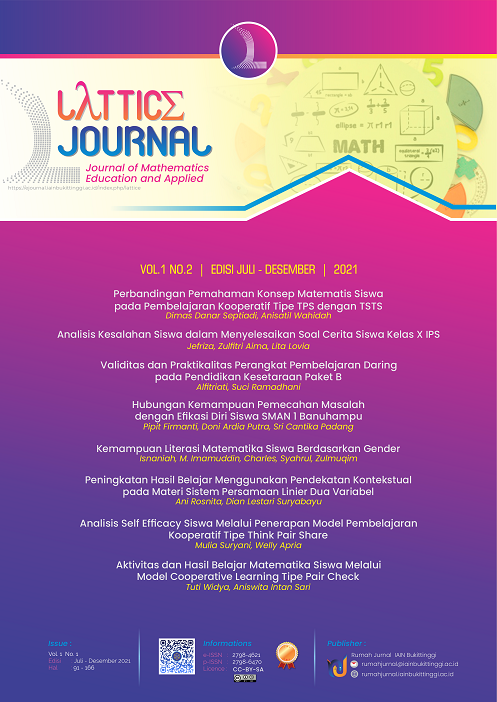Analisis Kesalahan Siswa dalam Menyelesaikan Soal Cerita Siswa Kelas X IPS
DOI:
https://doi.org/10.30983/lattice.v1i2.5017Keywords:
Analisis Kesalahan, soal cerita, prosedur NewmanAbstract
This research is motivated by the many mistakes made by students in solving story problems. The purpose of this study was to find out the mistakes made by students in solving story problems on Trigonometry material and to find out the causes of errors made by students in working on story problems on Trigonometry material. This research method uses a descriptive method with a qualitative approach. The subjects of this study were students of class X IPS SMA PGRI 3 Padang in the 2020/2021 academic year who had been selected by total sampling. Instruments used for data collection in the form of tests, interviews, and documentation. The test results were analyzed based on the error according to Newman. The results showed that some students made mistakes in understanding, errors in transforming, errors in processing skills, errors in writing the final answer. The cause of this error is that students do not know what is actually being asked in the problem, and accidentally get information on the question, so they cannot complete the information for the next step, do not understand how it turns into a question. mathematical models, and not proficient in counting.
Â
Penelitian ini dilatarbelakangi dengan banyaknya kesalahan yang dilakukan peserta didik dalam menyelesaikan soal cerita. Tujuan penelitian ini untuk mengetahui kesalahan yang dilakukan siswa dalam menyelesaikan soal cerita pada materi Trigonometri dan mengetahui penyebab terjadinya kesalahan yang dilakukan oleh siswa dalam mengerjakan soal cerita pada materi Trigonometri. Metode penelitian ini menggunakan metode deskriptif dengan pendekatan kualitatif. Subjek penelitian ini siswa kelas X IPS SMA PGRI 3 Padang Tahun Ajaran 2020/2021 yang telah dipilih secara total sampling. Instrument yang digunakan untuk pengumpulan data berupa tes, wawancara, dan dokumentasi. Hasil tes dianalisis berdasarkan kesalahan menurut Newman. Hasil penelitian menunjukkan sebagian siswa melakukan kesalahan dalam memahami, kesalahan dalam mentransformasi, kesalahan dalam keterampilan proses kesalahan penulisan jawaban akhir. Penyebab kesalahan ini adalah siswa tidak mengetahui apa yang sebenarnya ditanyakan dalam soal, dan tidak sengaja mendapatkan informasi pada soal tersebut, sehingga mereka tidak dapat melengkapi informasi untuk langkah selanjutnya, tidak mengerti bagaimana menjelma menjadi sebuah pertanyaan. model matematika, dan tidak mahir dalam menghitung.
References
Alamsyah, I. (2020). Analisis Kesalahan Dalam Menyelesaikan Soal Cerita Ditinjau Dari Kemampuan Pemecahan Masalah Berdasarkan Prosedur Newman (Doctoral dissertation, Universitas Pancasakti Tegal).
Arifin, Zainal. 2012. Penelitian Pendidikan Metode Dan Paradigma Baru. Bandung: Rosdakarya
Arikunto, S. 2016. Dasar Dasar Evaluasi Pendidikan Edisi Kedua. Jakarta: PT Bumi Aksara.
Badaruddin, dkk. 2016. “Analisis Kesalahan dalam Menyelesaikan Soal-Soal Operasi Hitung Pecahan pada Siswa Kelas VII SMP Negri 10 Kendariâ€. Jurnal Penelitian Pendidikan Matematika Volume 4 No. 2 , 44.
Felayani, Meirita Rahma. 2013. Pembentukan Karakter Dan Pemecahan Masalah Melalui Model Probing Prompting Berbantuan Scaffolding Materi Baris Dan Deret Kelas XI SMK. Skripsi: UNNES
Gaya, Dari, and Kognitif Mahasiswa. 2017. “Analisis Kesalahan Berdasarkan.†Aksioma 8(1): 17–30
Hartini. 2008. Analisis Kesalahan Siswa Menyelesaikan Soal Cerita pada Kompetensi Dasar Menemukan Sifat dan Menghitung Besaran-Besaran Segi Empat Siswa Kelas VII Semester II SMP Nur Hidayah Surakarta Tahun Pelajaran 2006/ 2007. UNS: Tesis.
Isnani, Waluya, S. B., Rochmad, Wardono. (2020, April). Analysis of mathematical creativity in mathematics learning is open ended. In Journal of Physics: Conference Series, (Vol. 1511, No. 1, p. 012102).
Jha, Shio Kumar. 2012. “Mathematics Performance of Primary School Students in Assam (India): An Analysis Using Newman Procedure.†International Journal of Computer Applications in in Engineering Sciences II(I): 17–21.
Lestari, T. 2015. Kumpulan Teori untuk Kajian Pustaka Penelitian Kesehatan. Yogyakarta: Nuha Medika.
Moleong, L.J. 2004. Metodologi Penelitian Kualitatif. Bandung: PT Remaja.
Praktitipong, Natcha, and Satoshi Nakamura. 2006. “Analysis of Mathematics Performance of Grade Five Students in Thailand Using Newman Procedure.†Journal of International Cooperation in Education, 9(1): 111–12.
Rahardjo dan Astuti. 2011. Pembelajaran Soal Cerita Pada Operasi Hitung Campuran di SD. Yogyakarta: Pusat Pengembangan dan Pemberdayaan Pendidik dan Tenaga Kependidikan Matematika.
Rr Chusnul, C., Mardiyana, and S. Dewi Retno. 2017. “Errors Analysis of Problem Solving Using the Newman Stage after Applying Cooperative Learning of TTW Type.†AIP Conference Proceedings 1913(December).
Santoso, D. A., A. Farid, and B. Ulum. 2017. “Error Analysis of Students Working about Word Problem of Linear Program with NEA Procedure.†Journal of Physics: Conference Series 855(1).
Singh, Parmjit, Arba Abdul Rahman, and Teoh Sian Hoon. 2010. “The Newman Procedure for Analyzing Primary Four Pupils Errors on Written Mathematical Tasks: A Malaysian Perspective.†Procedia - Social and Behavioral Sciences 8(5): 264–71. http://dx.doi.org/10.1016/j.sbspro.2010.12.036.
Yuliyanti, E. (2020). Analisis Kesalahan Peserta Didik Dalam Menyelesaikan Soal Cerita Matematika (Studi Penelitian pada Peserta Didik Kelas X SMK Muhammadiyah Kramat Semester Ganjil Tahun Ajaran 2019/2020)(Doctoral dissertation, Universitas Pancasakti Tegal).
Downloads
Published
How to Cite
Issue
Section
Citation Check
License
Authors who publish with Lattice Journal : Journal of Mathematics Education and Applied agree to the following terms: Authors retain copyright and grant the Lattice Journal : Journal of Mathematics Education and Applied right of first publication with the work simultaneously licensed under a Creative Commons Attribution License (CC BY-SA 4.0) that allows others to share (copy and redistribute the material in any medium or format) and adapt (remix, transform, and build upon the material) the work for any purpose, even commercially with an acknowledgement of the work's authorship and initial publication in Lattice Journal : Journal of Mathematics Education and Applied. Authors are able to enter into separate, additional contractual arrangements for the non-exclusive distribution of the journal's published version of the work (e.g., post it to an institutional repository or publish it in a book), with an acknowledgement of its initial publication in Lattice Journal : Journal of Mathematics Education and Applied. Authors are permitted and encouraged to post their work online (e.g., in institutional repositories or on their website) prior to and during the submission process, as it can lead to productive exchanges, as well as earlier and greater citation of published work (See The Effect of Open Access).



